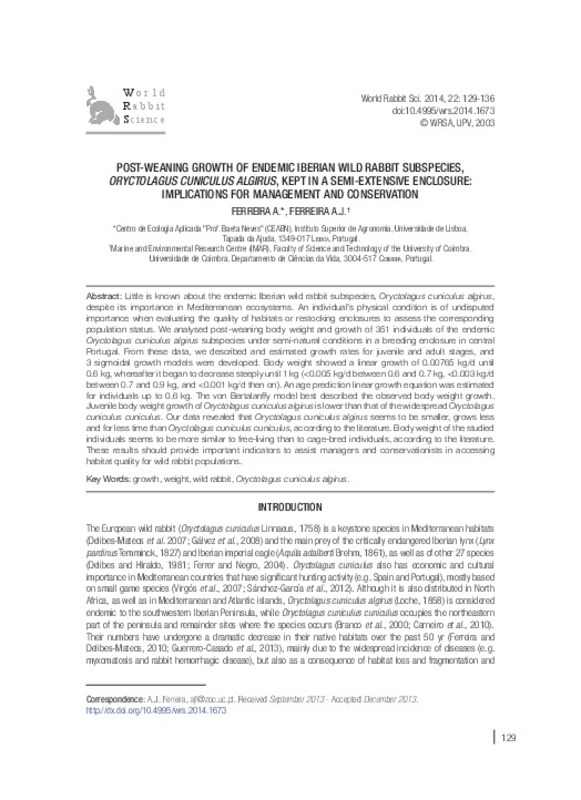JavaScript is disabled for your browser. Some features of this site may not work without it.
Buscar en RiuNet
Listar
Mi cuenta
Estadísticas
Ayuda RiuNet
Admin. UPV
Post-weaning growth of endemic Iberian wild rabbit subspecies, Oryctolagus cuniculus algirus, kept in a semi-extensive enclosure : implications for management and conservation
Mostrar el registro sencillo del ítem
Ficheros en el ítem
| dc.contributor.author | Ferreira, A.
|
es_ES |
| dc.contributor.author | Ferreira, A.J.
|
es_ES |
| dc.date.accessioned | 2014-09-12T09:52:49Z | |
| dc.date.available | 2014-09-12T09:52:49Z | |
| dc.date.issued | 2014-06-25 | |
| dc.identifier.issn | 1257-5011 | |
| dc.identifier.uri | http://hdl.handle.net/10251/39591 | |
| dc.description.abstract | [EN] Little is known about the endemic Iberian wild rabbit subspecies, Oryctolagus cuniculus algirus, despite its importance in Mediterranean ecosystems. An individual’s physical condition is of undisputed importance when evaluating the quality of habitats or restocking enclosures to assess the corresponding population status. We analysed post-weaning body weight and growth of 351 individuals of the endemic Oryctolagus cuniculus algirus subspecies under semi-natural conditions in a breeding enclosure in central Portugal. From these data, we described and estimated growth rates for juvenile and adult stages, and 3 sigmoidal growth models were developed. Body weight showed a linear growth of 0.00765 kg/d until 0.6 kg, whereafter it began to decrease steeply until 1 kg (<0.005 kg/d between 0.6 and 0.7 kg, <0.003 kg/d between 0.7 and 0.9 kg, and <0.001 kg/d then on). An age prediction linear growth equation was estimated for individuals up to 0.6 kg. The von Bertalanffy model best described the observed body weight growth. Juvenile body weight growth of Oryctolagus cuniculus algirus is lower than that of the widespread Oryctolagus cuniculus cuniculus. Our data revealed that Oryctolagus cuniculus algirus seems to be smaller, grows less and for less time than Oryctolagus cuniculus cuniculus, according to the literature. Body weight of the studied individuals seems to be more similar to free-living than to cage-bred individuals, according to the literature. These results should provide important indicators to assist managers and conservationists in accessing habitat quality for wild rabbit populations. | es_ES |
| dc.language | Inglés | es_ES |
| dc.publisher | Editorial Universitat Politècnica de València | |
| dc.relation.ispartof | World Rabbit Science | |
| dc.rights | Reserva de todos los derechos | es_ES |
| dc.subject | Growth | es_ES |
| dc.subject | Weight | es_ES |
| dc.subject | Wild rabbit | es_ES |
| dc.subject | Oryctolagus | es_ES |
| dc.subject | Cuniculus algirus | es_ES |
| dc.title | Post-weaning growth of endemic Iberian wild rabbit subspecies, Oryctolagus cuniculus algirus, kept in a semi-extensive enclosure : implications for management and conservation | es_ES |
| dc.type | Artículo | es_ES |
| dc.date.updated | 2014-09-12T09:37:40Z | |
| dc.identifier.doi | 10.4995/wrs.2014.1673 | |
| dc.rights.accessRights | Abierto | es_ES |
| dc.description.bibliographicCitation | Ferreira, A.; Ferreira, A. (2014). Post-weaning growth of endemic Iberian wild rabbit subspecies, Oryctolagus cuniculus algirus, kept in a semi-extensive enclosure : implications for management and conservation. World Rabbit Science. 22(2):129-136. https://doi.org/10.4995/wrs.2014.1673 | es_ES |
| dc.description.accrualMethod | SWORD | es_ES |
| dc.relation.publisherversion | https://doi.org/10.4995/wrs.2014.1673 | es_ES |
| dc.description.upvformatpinicio | 129 | es_ES |
| dc.description.upvformatpfin | 136 | es_ES |
| dc.type.version | info:eu-repo/semantics/publishedVersion | es_ES |
| dc.description.volume | 22 | |
| dc.description.issue | 2 | |
| dc.identifier.eissn | 1989-8886 | |
| dc.description.references | Branco, M., Ferrand, N., & Monnerot, M. (2000). Phylogeography of the European rabbit (Oryctolagus cuniculus) in the Iberian Peninsula inferred from RFLP analysis of the cytochrome b gene. Heredity, 85(4), 307-317. doi:10.1046/j.1365-2540.2000.00756.x | es_ES |
| dc.description.references | Carneiro, M., Blanco-Aguiar, J. A., Villafuerte, R., Ferrand, N., & Nachman, M. W. (2010). SPECIATION IN THE EUROPEAN RABBIT (ORYCTOLAGUS CUNICULUS): ISLANDS OF DIFFERENTIATION ON THE X CHROMOSOME AND AUTOSOMES. Evolution, 64(12), 3443-3460. doi:10.1111/j.1558-5646.2010.01092.x | es_ES |
| dc.description.references | Cooke S.J., Sack L., Franklin C.E., Farrell A.P., Beardall J., Wikelski M., Chown S.L. 2013. What is conservation physiology? Delibes M., Hiraldo F. 1981. The rabbit as prey in the Iberian Mediterranean ecosystem. In: Myer K., MacInnes C. (eds) Proceedings of the I World Lagomorph Conference, University of Guelph, Ontario, 614-622. | es_ES |
| dc.description.references | Delibes-Mateos M., Ramírez E., Ferreras E., Villafuerte R. 2008. Translocations as a risk for the conservation of European wild Ferreira C., Touza J., Rouco C., Díaz-Ruiz F., Fernandez-e-Simon | es_ES |
| dc.description.references | Gálvez, L., López-Pintor, A., De Miguel, J. M., Alonso, G., Rueda, M., Rebollo, S., & Gómez-Sal, A. (2008). Ecosystem Engineering Effects of European Rabbits in a Mediterranean Habitat. Lagomorph Biology, 125-139. doi:10.1007/978-3-540-72446-9_9 | es_ES |
| dc.description.references | Gibb J.A. 1990. The European Rabbit. In: Chapman J.A., Flux J.E. (eds) Rabbits, hares and pikas: status survey and conservation action plan. IUCN, Switzerland, 116-120. | es_ES |
| dc.description.references | Gibb J.A., White A.J., Ward C.P. 1985. Population ecology of rabbits in the Wairarapa, New Zealand. New Zeal. J. Ecol., 8: 55-82. | es_ES |
| dc.description.references | Simberloff D. 1996. Hybridization between native and introduced wildlife species: importance for conservation. Wildlife Biol., 2: 143-150. | es_ES |
| dc.description.references | Soriguer R.C. 1980. El conejo, Oryctolagus cuniculus (L), en Andalucía Occidental: Parámetros corporales y curva de crecimiento. Do-ana, Acta Vertebr., 7: 83-90. | es_ES |
| dc.description.references | Ward D. 2005. Reversing Rabbit Decline: one of the biggest challenges for nature conservation in Spain and Portugal. Technical report. World Conservation Union, Gland, Switzerland. | es_ES |
| dc.description.references | Williams K., Parer I., Coman B., Burley J., Braysher M. 1995. Managing Vertebrate Pests: Rabbits. Bureau of Resource Sciences/CSIRO Division of Wildlife and Ecology, Canberra. | es_ES |
| dc.description.references | Zuur, A. F., Ieno, E. N., & Smith, G. M. (2007). Analysing Ecological Data. Statistics for Biology and Health. doi:10.1007/978-0-387-45972-1 | es_ES |








